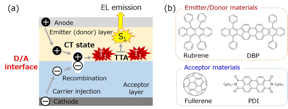Home > Press > Organic light emitting diodes operated by 1.5 V battery
 |
| Fig. 1 (a) Schematic of the device structure and the operating mechanism of OLEDs. (b) Chemical structures. CREDIT NINS/IMS |
Abstract:
Various properties of organic light-emitting diodes (OLEDs) have been optimized, including current to photon conversion efficiency. An external quantum efficiency exceeding 20%, with internal quantum efficiency of 100%, has been achieved owing to the development of thermally activated delayed fluorescent and phosphorescent materials that manage the spin of excited states. However, the operating voltage of common types of OLEDs is very high; that of an OLED emitting approximately 600-nm light at a luminance of 100 cd/m2, which is a general display condition, is as high as 4.5 V.
Organic light emitting diodes operated by 1.5 V battery
Tokyo, Japan | Posted on January 7th, 2022Group of Assistant Professor Seiichiro Izawa and Professor Masahiro Hiramoto at Institute for Molecular Science in Japan, and Associate Professor Masahiro Morimoto and Professor Shigeki Naka at University of Toyama in Japan report that an efficient OLED, operable by a 1.5-V battery, that produces bright emission equivalent to luminance of a typical display. The OLED has a smaller turn-on voltage at 0.97 V than the optical energy of emitted photons at 2.04 eV (608 nm), because the OLED is based on upconversion (UC) transition associated with triplet–triplet annihilation that doubles the energy of excited states (Fig. 1). They reveal that the characteristics of charge transfer (CT) state at the interface are key to efficient UC, and the percentage of excited states deactivated by parasitic loss processes during the UC transition is significantly reduced from over 90% to approximately 10% by introducing a highly crystalline acceptor material and an emissive dopant. Consequently, the UC-OLED reaches 100 cd/m2 at a voltage and emission wavelength of 1.33 V and 608 nm (2.04 eV), respectively (Fig. 2a). This is the lowest operating voltage reported for an OLED that achieves a luminance of 100 cd/m2. It was further demonstrated that the UC-OLED can be operated by a 1.5-V battery to realize luminance of 177 cd/m2 (Fig. 2b).
####
For more information, please click here
Contacts:
Hayao KIMURA
National Institutes of Natural Sciences
Office: 81-354-251-890
Expert Contact
Seiichiro Izawa
Institute for Molecular Science
Office: +81-564-59-5537
Copyright © National Institutes of Natural Sciences
If you have a comment, please Contact us.Issuers of news releases, not 7th Wave, Inc. or Nanotechnology Now, are solely responsible for the accuracy of the content.
| Related Links |
| Related News Press |
News and information
![]() Researchers develop molecular qubits that communicate at telecom frequencies October 3rd, 2025
Researchers develop molecular qubits that communicate at telecom frequencies October 3rd, 2025
![]() Next-generation quantum communication October 3rd, 2025
Next-generation quantum communication October 3rd, 2025
![]() "Nanoreactor" cage uses visible light for catalytic and ultra-selective cross-cycloadditions October 3rd, 2025
"Nanoreactor" cage uses visible light for catalytic and ultra-selective cross-cycloadditions October 3rd, 2025
Display technology/LEDs/SS Lighting/OLEDs
![]() Spinel-type sulfide semiconductors to operate the next-generation LEDs and solar cells For solar-cell absorbers and green-LED source October 3rd, 2025
Spinel-type sulfide semiconductors to operate the next-generation LEDs and solar cells For solar-cell absorbers and green-LED source October 3rd, 2025
![]() Efficient and stable hybrid perovskite-organic light-emitting diodes with external quantum efficiency exceeding 40 per cent July 5th, 2024
Efficient and stable hybrid perovskite-organic light-emitting diodes with external quantum efficiency exceeding 40 per cent July 5th, 2024
Organic Electronics
![]() Unveiling the power of hot carriers in plasmonic nanostructures August 16th, 2024
Unveiling the power of hot carriers in plasmonic nanostructures August 16th, 2024
![]() Efficient and stable hybrid perovskite-organic light-emitting diodes with external quantum efficiency exceeding 40 per cent July 5th, 2024
Efficient and stable hybrid perovskite-organic light-emitting diodes with external quantum efficiency exceeding 40 per cent July 5th, 2024
Possible Futures
![]() Spinel-type sulfide semiconductors to operate the next-generation LEDs and solar cells For solar-cell absorbers and green-LED source October 3rd, 2025
Spinel-type sulfide semiconductors to operate the next-generation LEDs and solar cells For solar-cell absorbers and green-LED source October 3rd, 2025
Discoveries
![]() Researchers develop molecular qubits that communicate at telecom frequencies October 3rd, 2025
Researchers develop molecular qubits that communicate at telecom frequencies October 3rd, 2025
![]() Next-generation quantum communication October 3rd, 2025
Next-generation quantum communication October 3rd, 2025
![]() "Nanoreactor" cage uses visible light for catalytic and ultra-selective cross-cycloadditions October 3rd, 2025
"Nanoreactor" cage uses visible light for catalytic and ultra-selective cross-cycloadditions October 3rd, 2025
Announcements
![]() Rice membrane extracts lithium from brines with greater speed, less waste October 3rd, 2025
Rice membrane extracts lithium from brines with greater speed, less waste October 3rd, 2025
![]() Researchers develop molecular qubits that communicate at telecom frequencies October 3rd, 2025
Researchers develop molecular qubits that communicate at telecom frequencies October 3rd, 2025
![]() Next-generation quantum communication October 3rd, 2025
Next-generation quantum communication October 3rd, 2025
![]() "Nanoreactor" cage uses visible light for catalytic and ultra-selective cross-cycloadditions October 3rd, 2025
"Nanoreactor" cage uses visible light for catalytic and ultra-selective cross-cycloadditions October 3rd, 2025
Interviews/Book Reviews/Essays/Reports/Podcasts/Journals/White papers/Posters
![]() Spinel-type sulfide semiconductors to operate the next-generation LEDs and solar cells For solar-cell absorbers and green-LED source October 3rd, 2025
Spinel-type sulfide semiconductors to operate the next-generation LEDs and solar cells For solar-cell absorbers and green-LED source October 3rd, 2025
![]() Rice membrane extracts lithium from brines with greater speed, less waste October 3rd, 2025
Rice membrane extracts lithium from brines with greater speed, less waste October 3rd, 2025
|
|
||
|
|
||
| The latest news from around the world, FREE | ||
|
|
||
|
|
||
| Premium Products | ||
|
|
||
|
Only the news you want to read!
Learn More |
||
|
|
||
|
Full-service, expert consulting
Learn More |
||
|
|
||








